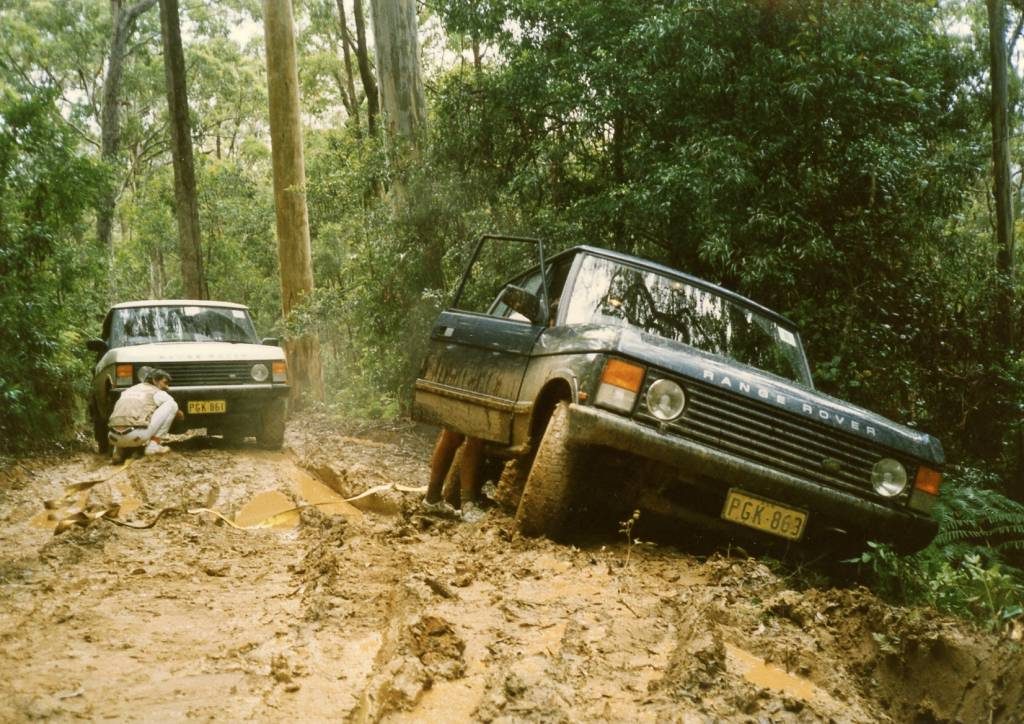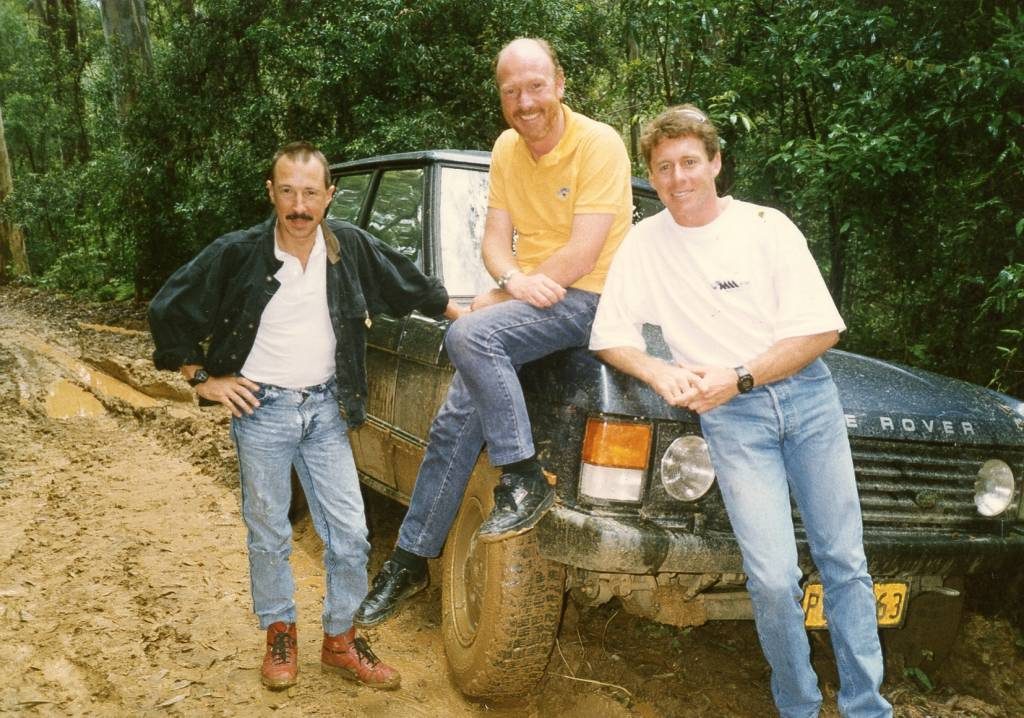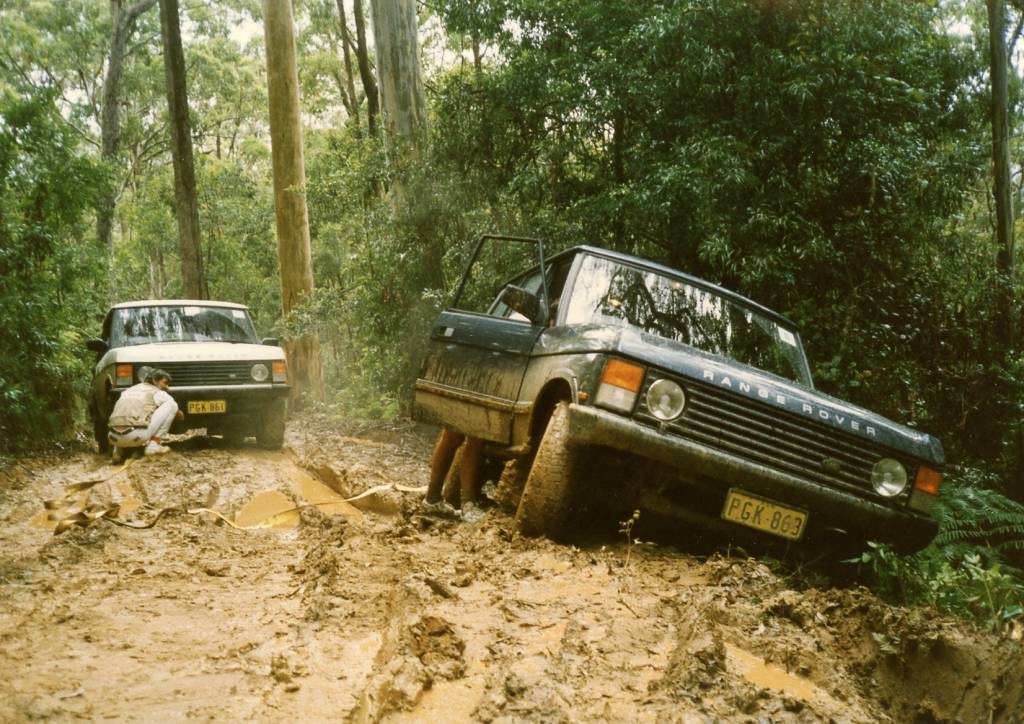I dive into my photo archives for this one. The term “archive” is used loosely because, sadly, my film photos-slides, negatives and prints are contained in a large selection of cardboard boxes without even an attempt at a cataloguing system. So many photos, so little system.
I came across these two pictures whilst searching for some slides on a totally different subject. The photos you see here are flatbed scans of postcard-sized prints because the original colour negatives discoloured long ago.
The images were taken on a Range Rover media launch in Australia in 1987. The 1987 model year Range Rover had the new feature of electronic fuel injection — previously it had relied on good old-fashioned carburettors. Back then, we used any excuse to demonstrate the Range Rover’s off

No cheap affairs
At that time Australia had four monthly specialist four-wheel-drive magazines, plus regular motoring columns in the general newspapers as well as three monthly car magazines. So a media launch had to accommodate a sizeable contingent of journalists and were most definitely not cheap affairs.
From what I hear, the motoring media scene is very different nowadays. Some of the social media “influencers” who are invited to the launches can just about manage to drive their Audi A2 to the local cafe for smashed avocado on sourdough toast washed down with a chai soy latte, let alone drive an SUV through knee-deep mud. Come to think of it, the same observation could apply to social media influencers in the photo industry – in relation to their photographic abilities, I mean.
The Australian Land Rover/Range Rover importer had established an industry-wide reputation for staging the most interesting and gruelling new-model launches. They were always off-road, somewhere in Australia, and hopefully always fun. The 1987 launch was into some particularly rough country in an isolated state forest inland from Port Macquarie in New South Wales.
I was reminded of the launch when I drove through the area on one of Australia’s best driving roads a few weeks ago on the Porsche road trip. From the map I see that it is now a state conservation area, so probably no more Range Rover launches there. But I very much doubt that they would want to go there now anyway.
Plans of mice and men
The plan for the day back in 1987 was for the journalists to fly into Port Macquarie early morning to meet the Range Rovers lurking in the airport car park. We were to drive the very twisty Oxley Highway west for 98km before turning off into the state forest. Then it was off
There was plenty of evidence of the mining activity which had ended in the early 1900s. A massive rusty stamper battery used for crushing, very rusty boilers and other pieces of heavy equipment littered the floor of the valley.
It must have been an extraordinary feat to move all that heavy equipment. It had been bought by sea to Port Macquarie from Sydney and then pulled up the very steep dirt track by bullock teams. They would have used the same teams to take the equipment down the steep slopes, using ropes around trees to act as anchors.
You could still see wear or burn marks from the ropes on some of the trees on the descent. It would have been difficult and dangerous work. Yet, the lure of gold has always inspired
The descent into The Cells in the Range Rovers was straightforward, although heavy rain in the preceding weeks had swollen the three rivers we had to cross at the valley floor.
Full wellie
It was on the way out on a very steep track that the real problems arose. The track consisted of waterlogged red clay. The lead vehicle, a Land Rover Defender packed with recovery gear and equipped with a winch, just made it onto a hard patch, well up the ascent, thanks to a lot of revs and despite enormous wheel spin.
After that, it was a mud bath. That first vehicle had turned the track into a quagmire and the next vehicle to go up was being driven by Wayne Gardener, who had just won the motorcycle 500cc World Championship, and who was our special guest.
He had come along for the fun. Well, Wayne gave it full wellie and he gained a lot of momentum. So much momentum, in fact, that he nearly careered off the track and over the edge into the ravine. Fortunately, the car teetered on the edge and then sank into the mud. It was extracted by winching by the vehicle uphill, with the following Range Rover attached by a strap to act as an anchor in case Wayne and his car slid away.
We pulled ten cars up that track with winches and a lot of wheel-spin. By the time the last one was hauled clear, the mud was so deep that the off-roader was up to its axles in mud. The second photo shows the happy Range Rover team after they had been extracted. Wayne Gardener is on the right and he was obviously enjoying the day. I guess if you are a motorcycle world champion the prospect of falling off a track into a very deep ravine is not so daunting, particularly if the expensive piece of offroadery you are driving is not your own.

Leica not recommended
As I was working on these launches I did not have as many opportunities to take photos as I would have liked. Initially, I used my Leica M4-P for photos on these launches but I was always concerned about dust, mud and water. Therefore, I switched to a Ricoh FF70, a point-and-shoot camera which, in common with so many
That Nikon was so tough you could literally drop it into the mud, rinse it off and carry on. It proved to be ideal for Land Rover launches and I took it on an expedition into the Tanami Desert in Western Australia a few years later. It was just as well I did not take my then Leica M6 because the sand in the desert is so fine it could get in anywhere. It would have wrecked the M6 on the first day.
By the end of our afternoon of winching Range Rovers up that track, we were way behind schedule. We had to drive very rapidly and mine was the first vehicle back to the hotel in Port Macquarie. As I pulled into the driveway, the young lad who was the porter came over and said that he had heard that Wayne Gardener was coming in and he’d like to get his autograph.
Leeching on
Back then, Wayne Gardener was very much an Aussie hero and the lad looked at my boots and then volunteered to clean all our boots if I could secure him Gardener’s autograph. Knowing the state of our boots, I volunteered to introduce him to Wayne but insisted all he had to do was clean just my boots. When I saw the others arrive I am sure he sighed a large sigh of relief. And, yes, he met Wayne Gardener.
Fortunately, he did not see my socks after I removed my boots. They were covered in blood. I had to remove at least six leeches from my feet using salt. It had been an eventful day.


Like any Australian motorcycle fan through that era, Wayne Gardner was a hero of mine. Absolute legend who rode every bike as hard as he possibly could, whatever the circumstances.
Many thanks for the story, John. Hope you have been, and are, well.
Hi, I really enjoyed your article. It makes me want to relook at slides from the 70s when I climbed mount Glittertend in Norway. I went alone which was less than wise but I used to be invincible until I was in my 30s. The great thing about photography is we can remember our past – thanks for reminding me about that important aspect of photography. You obviously enjoyed some great adventures and I hope they continue for you!
When cars, were really cars, and really needed a driver to know how to use them – unlike the bland neutralised things we use today, with their sterile handling and eco-friendly (apparently) engines. In the UK all the fun has been taken out of driving, but speed cameras, tolls and poorly driven cars.
Nice images and story John, I can’t even begin to think what might roll out of your archive next. Heck, I reckon even you don’t know what will roll out. You might need to invite Mike down under to organise and sort your back catalogue.
I think John’s cardboard boxes are probably better organised than mine. In fact, I’ve given up an really don’t have much that I could now find, pre digital that is. And I’m crap at indexing and tagging so I am forever searching the database looking for that photo I knew I too four (or was it five) years ago.
Not all modern cars are soulless but I agree that there is no pleasure left in driving, certainly not in the crowded south east where we both live.
It isn’t a great deal better up North at the moment. On my way back from Whitby last Saturday, I estimated that the queue to get in to Whitby started near Malton, ran all the way to York, there was a gap of a mile or two and then it ran all the way to the A1.
Oddly coming back wasn’t too bad. With the exception of the speed of stuff in the South. People drove faster and more erratically.
I hate driving in the UK at the moment.
I don’t disagree on your final point. And remember that the M6, that long streak of misery, runs right up through the north. I have the distinction of having been a tyro journalist sent up from London (on a Lambretta scooter) to report on the opening of the M6 by the then transport minister Ernest Marples.
We foregathered at the Charnock Richard service station just north of Wigan to hear the good words, then mounted a double-decker bus for the ride to the end of the motorway, which I seem to remember wasn’t far south of Warrington. That stretch of road has been on a fast downward trajectory ever since.
And, while I am reminiscing, I rode my ancient AJS 500 cc Competition bike on the Preston By-pass, the day it opened some years before the M6 (which it formed a part of). That was my first experience of a German-style Autobahn.
However, and this is an important point, I am constantly told by younger people that there was no traffic on the roads in those days. This is absolutely not true. There were awful traffic jams, meandering right through the middle of villages and towns, dreadfully haphazard parking in towns (before the meter came along) and driving could be something of a misery. Times change, but at least we can get a move on when traffic permits.
In those pre-motorway years I was working in London but my home was in Lancashire. I did the 210 miles in five hours (all on A and B roads) on my little Honda 125cc Super Sports. Now it takes five hours in my car, thanks to the horrors of the M6. The train takes two hours for the same journey…..
“..there was no traffic on the roads in those days. This is absolutely not true. There were awful traffic jams, meandering right through the middle of villages and towns, dreadfully haphazard parking in towns (before the meter came along) and driving could be something of a misery..”
Exeter by-pass and A30 to Cornwall pre-motorway? Caravans head to tail. Every Easter there was always film on BBC tv news of the how-many-mile? static tailback of cars bumper to bumper and going nowhere.
The M6 was my regular route from Manchester to the theatre at Stratford and, of course, to London. Many bridges were painted with ‘Marples Must Go’, and you knew you were approaching London – we-ell, Luton – because, for some unfathomable reason, there was the slogan “The Tea Set” painted on the bridge buttress just by the Luton turn off.
For our holidays in Brighton, my father wrote to the AA for one of their planned route maps, asking for a journey through the most picturesque countryside, and avoiding any A roads or motorways! We drove down a few A roads, past the plastic-three-wheeler Robin Reliant factory at Tamworth, but then (..unless I’m dreaming..) through Bourton-on-the-Water and Broadway and other charming grass-verged archetypical English villages (..never got to Shaftesbury, though ..wrong direction).
Them were’t’ days, when families parked in a lay-by beside, say, the main road northwards out of Bury or Bolton, got out the sandwiches and the Thermos and the tinny fold-away metal deckchairs and the camping stove, and they’d have dainty afternoon tea amidst the exhaust fumes ..and when the AA motorcyclists saluted you as they passed, and the Smiths Crisps vans had – stop me if I’ve told you this – painted on the side: “We wish to extend to you the courtesy of the road; please sound your horn when passing”.
Eh up.
My Beloved had a friend (female) in Paris, whose then latest boyfriend had some kind of “off-road VW” but really, really wanted a Range Rover.
My pal Ken had just – implausibly – got himself a job as a farm manager in Devon (on the basis of taking back to England some yacht he’d come across in a French river). And his boss, he said, had a Lincoln Green Range Rover which, apparently, had belonged to the (notorious?) Janie Jones (a British singer who’d got herself into some Christine Keeler / Mandy Rice-Davies trouble) and the RR was available if anyone wanted to buy it.
So we took the train to Okehampton, I think, and Ken met us at the station (..no, maybe it was Exeter..) and took us to the farm and the RR which we took for a spin around the tracks and meadows, and it seemed to be OK ..except there was a dreadful lurch as you (manually) changed gear ..play in the intermediate diff, perhaps, or all those prop-shaft joints, maybe ..were they all like that?
Then we dashed to the Plymouth to Roscoff ferry – though Robin (its owner) rang ahead to have us stopped, as we’d handed over a banker’s draft instead of a cheque, and Robin didn’t seem to know what those were. But instead of driving straight to Paris we decided to amble around Brittany for a week (..this was about 1975, I think..) and then afterwards deliver it to the City of Light.
We had a great trip around Normandy, Brittany, and whatever you’d call the route to the capital, but my Beloved has a hard right foot and a very quick left foot, and every gear change was enough to give you whiplash! [..My driving’s a bit different, as I once was a mini-cab driver, taking home tired broadcasters at 2am from Bush House at the Aldwych (central London). So my driving’s a little smoother.]
Needless to say, “Jean”, the boyfriend, never paid for the car, and so we went back two or three years later to reclaim it. Perhaps you know what Paris parking is (was?) like? It consists of ramming adjacent cars apart till there’s just enough room to slice off your paintwork as you fit nice and snug between their fore and aft bumpers. Astonishingly, the RR had no dents or damage at all ..must have been those VERY tough steel (..cast iron?..) front and rear fenders!
Never driven one since ..the latest ones look like girly toys, not the ruff tuff tractors which the originals were!